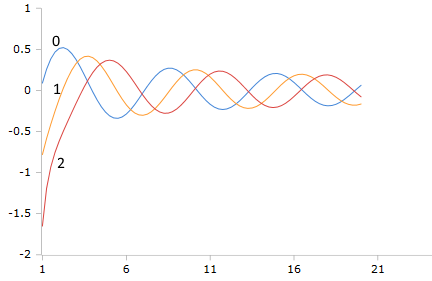Bessel-Y Function for Complex Numbers
Calculation of the Bessel function \(Y_\nu(z)\) of the second kind (Neumann function) with oscillatory behavior
Bessel-Y Function Calculator
Bessel Function \(Y_\nu(z)\) of the Second Kind
The Bessel function of the second kind \(Y_\nu(z)\) (also called Neumann function) exhibits oscillatory behavior and is singular at the origin. It is a linearly independent solution of the Bessel differential equation.
Bessel-Y Properties
Behavior
Oscillatory
Similar to \(J_\nu\)
Wave functionOrigin
Singular
At z = 0
\(Y_\nu(0) = -\infty\)Order
ν ∈ ℝ
Any real number
Integer or rationalArgument
z ∈ ℂ
Complex: a+bi
Real and imaginary partImportant Properties
- Solution of the Bessel differential equation
- Linearly independent from \(J_\nu(z)\)
- Singularity: \(Y_0(z) \sim \frac{2}{\pi}\ln(z)\) for small z
- Asymptotically: \(Y_\nu(z) \sim \sqrt{\frac{2}{\pi z}} \sin(z - \frac{\nu\pi}{2} - \frac{\pi}{4})\)

Plot of the Bessel-Y function with orders 0, 1, and 2
Definition of the Bessel-Y Function (Neumann Function)
The Bessel function of the second kind \(Y_\nu(z)\), also called Neumann function or Weber function, is defined by:
Standard Definition
Definition through the Bessel functions of the first kind \(J_\nu(z)\) and \(J_{-\nu}(z)\)
Bessel Differential Equation
Differential equation with solutions \(w = J_\nu(z)\) and \(w = Y_\nu(z)\)
Wronskian Determinant
Proof of linear independence
|
|
Important Properties of the Bessel-Y Function
Asymptotic Behavior
Oscillatory for large |z| with decreasing amplitude
Behavior at Origin
Logarithmic or power singularity at origin
Symmetry Relations
Symmetry for integer orders
Recurrence Relations
Relationships between different orders
Calculation Example: \(Y_1(2+i)\)
Calculation: \(Y_1(z)\) via the definition:
\(Y_1(z) = \frac{J_1(z) \cos(\pi) - J_{-1}(z)}{\sin(\pi)}\)
Limit consideration: For integer ν, L'Hospital's rule is applied
\(Y_n(z) = \lim_{\nu \to n} \frac{J_\nu(z) \cos(\nu\pi) - J_{-\nu}(z)}{\sin(\nu\pi)}\)
Numerical result: \(Y_1(2+i)\) is complex with real and imaginary parts
Peculiarity: Singular at origin, oscillatory for large arguments
Applications of the Bessel-Y Function
Wave Propagation
Acoustics & Vibrations
Circular plates
Boundary value problems
Hollow cylinders
External fields
Electromagnetism
Waveguides
Antennas
Far-field patterns
Mathematical Physics
Potential theory
Green's functions
Boundary value problems
Integral transforms
Bessel-Y Functions (Neumann Functions) - Detailed Description
Oscillatory Behavior with Singularity
The Bessel function of the second kind \(Y_\nu(z)\) is a second, linearly independent solution of the Bessel differential equation. Unlike \(J_\nu(z)\), it is singular at the origin.
• Oscillatory behavior like \(J_\nu(z)\)
• Singularity at origin (z=0)
• Linearly independent from \(J_\nu(z)\)
• Complete basis with \(J_\nu\) for boundary value problems
Historical Background
The function was independently developed by Carl Neumann and Heinrich Martin Weber. It is therefore also called Neumann function \(N_\nu(z)\) or Weber function.
Physical Interpretation
In exterior problems, \(Y_\nu(r)\) often describes the outgoing wave in the far field, while \(J_\nu(r)\) represents the incoming or standing wave. The combination \(H_\nu^{(1)} = J_\nu + iY_\nu\) forms the Hankel function for outgoing waves.
Numerical Aspects
The calculation of \(Y_\nu(z)\) requires special care due to the singularity at the origin and the oscillatory behavior for large arguments.
• Caution near z=0 due to singularity
• Recurrence can be unstable
• Better stability backward
• Asymptotic expansion for large |z|
Calculation Methods
Different numerical methods are used depending on the argument range:
Medium |z|: Miller algorithm
Large |z|: Asymptotic expansion
Complex z: Special algorithms required
Relationship to Other Functions
Hankel functions:
\(H_\nu^{(1)}(z) = J_\nu(z) + iY_\nu(z)\) (outgoing wave)
\(H_\nu^{(2)}(z) = J_\nu(z) - iY_\nu(z)\) (incoming wave)
Comparison: Bessel-Y vs. Bessel-J
Bessel-Y Function (second kind)
Behavior: Oscillatory
Origin: Singular at z=0
Asymptotics: \(\sim \sqrt{\frac{2}{\pi z}} \sin(\cdots)\)
Application: Exterior problems
Bessel-J Function (first kind)
Behavior: Oscillatory
Origin: Finite at z=0
Asymptotics: \(\sim \sqrt{\frac{2}{\pi z}} \cos(\cdots)\)
Application: Interior problems
Application Guidelines
- Exterior problems: Combination \(J_\nu\) + \(Y_\nu\)
- Boundary values at z→∞: Hankel functions \(H_\nu^{(1,2)}\)
- Wave radiation: \(Y_\nu\) for outgoing waves
- Interior problems: Only \(J_\nu\) (finite at z=0)
- Singularity at boundary: \(Y_\nu\) allowed
- Complete basis: Combination of both functions
Bessel Functions - Complete Definitions and Relationships
Ordinary Bessel Functions
The Bessel function of the first kind of order n is defined as:
The Bessel function of the second kind (Neumann function) is:
Hankel Functions
Combinations of \(J_\nu\) and \(Y_\nu\) for wave problems:
\(H_\nu^{(1)}(z) = J_\nu(z) + iY_\nu(z)\) (outgoing wave)
\(H_\nu^{(2)}(z) = J_\nu(z) - iY_\nu(z)\) (incoming wave)
Modified Bessel Functions
The modified Bessel function of the first kind is:
The modified Bessel function of the second kind is:
Application Areas
The Bessel-Y function is indispensable for exterior problems with cylindrical symmetry, where singularities at z=0 are allowed. It is used in wave theory, acústics, electromagnetism, and many other areas of mathematical physics.
|
|
|
|
More complex functions
Absolute value (abs) • Angle • Conjugate • Division • Exponent • Logarithm to base 10 • Multiplication • Natural logarithm • Polarform • Power • Root • Reciprocal • Square root •Cosh • Sinh • Tanh •
Acos • Asin • Atan • Cos • Sin • Tan •
Airy function • Derivative Airy function •
Bessel-I • Bessel-Ie • Bessel-J • Bessel-Je • Bessel-K • Bessel-Ke • Bessel-Y • Bessel-Ye •